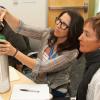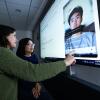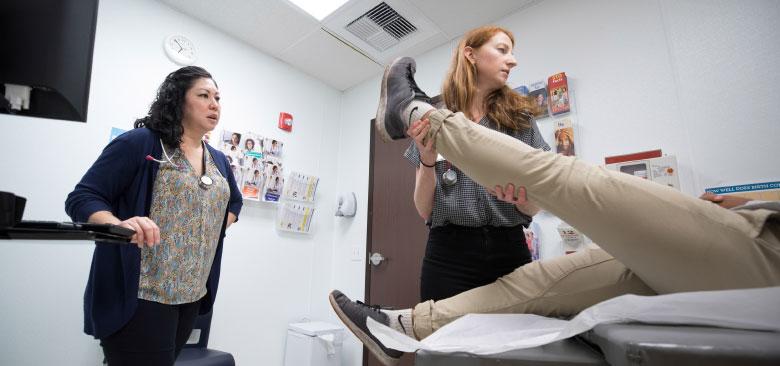
Nurse practitioner Melissa Wong works with student Patricia Sweeney at Petaluma Health Center’s Casa Grande High School health clinic (photo by Elisabeth Fall).
New Program Builds a Primary Care Workforce Tailored to Rural California
The United States Department of Agriculture’s Economic Research Service estimates that more than 800,000 Californians live in rural areas spread across the state’s 163,695 square miles. Many of them live and work in one of the state’s 640 federally designated Health Professional Shortage Areas (HPSAs) for primary care. With a new project – Rural Health Advanced Practice Training (RHAPT) – the UC San Francisco School of Nursing hopes to help fill the gaps by encouraging and training advanced practice nurses to work in rural settings.
Creating a Comprehensive Program
“We’ve always had students from rural areas who want to take their skills back to their communities,” says Erica Monasterio, clinical professor of Family Health Care Nursing and the project director for RHAPT, which is funded by a two-year Advanced Nursing Education Workforce (ANEW) Program grant from the Health Resources and Services Administration (HRSA). “We wanted to do something more intentional to prep students to practice in those communities.”
RHAPT has allowed the school to formalize and expand an academic clinical partnership between the School and the Redwood Community Health Coalition (RCHC), a network of 17 Federally Qualified Health Centers (FQHCs) in HPSAs in Northern California. Moreover, in implementing the grant, the team has built on lessons and experiences gleaned from another HRSA-funded project, the Central Valley Clinical-Academic Remodel – known as CV-CARE – now in its third year, which trains clinical faculty and provides clinical training for nurse practitioner (NP) students working with medically underserved communities in the Central Valley.
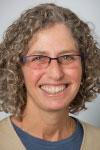 Erica Monasterio The team includes Elizabeth Gatewood, who has been directing clinical placements and creating the curriculum to train preceptors for the CV-CARE project, and Elizabeth Castillo, who has more than 11 years of experience practicing in rural settings; she has created a didactic program that brings clinicians with rural health experience to UCSF classrooms, in person or via technology. Their work has led to creation of a rural health minor at the School, which provides $10,000 in tuition support to help offset commuting or living expenses for students interested in working in rural communities. The first cohort of nine students is due to complete the rural health minor in May 2018.
Erica Monasterio The team includes Elizabeth Gatewood, who has been directing clinical placements and creating the curriculum to train preceptors for the CV-CARE project, and Elizabeth Castillo, who has more than 11 years of experience practicing in rural settings; she has created a didactic program that brings clinicians with rural health experience to UCSF classrooms, in person or via technology. Their work has led to creation of a rural health minor at the School, which provides $10,000 in tuition support to help offset commuting or living expenses for students interested in working in rural communities. The first cohort of nine students is due to complete the rural health minor in May 2018.
“In the past, we’ve done the clinical placements but haven’t supported them with the didactic content that’s specific to rural communities,” says Monasterio. Also, unlike in most clinical placements, students in the rural health minor commit to working full-time in the same clinic for five weeks, giving them a chance to get to know the communities they’re working in and their unique populations and challenges.
Unique Challenges
Those challenges are large. While access to care is an issue in any underserved area, there are additional barriers in rural communities, starting with the fact that in some instances, patients may need to travel several hours or more each way to attend a clinic. Specialty care can add another layer to the challenge. A care plan that works for a patient in an urban environment, where there is relatively speedy access to urgent or emergency care, may not work in a community where the nearest fully staffed emergency department is 100 miles from a patient’s home.
 Vanessa Gutierrez Vanessa Gutierrez is a second-year pediatric NP student in the rural health minor and has been doing her clinical rotation in Bishop, California, the only incorporated city in Inyo County, which sits at the state’s easternmost edge. She gives the example of a young patient who came to her clinic with what appeared to be a food allergy. The patient had a rash, and her mother reported she had had some difficulty breathing the previous night. Although the patient was in no significant distress during the clinic visit, Gutierrez and her preceptor didn’t want to send her and her mother away with nothing more than instructions to follow up with an allergist and go to the emergency department if there were any more breathing problems, so they gave the patient an EpiPen (epinephrine auto-injector) and painstakingly instructed both the patient and her mother in its use.
Vanessa Gutierrez Vanessa Gutierrez is a second-year pediatric NP student in the rural health minor and has been doing her clinical rotation in Bishop, California, the only incorporated city in Inyo County, which sits at the state’s easternmost edge. She gives the example of a young patient who came to her clinic with what appeared to be a food allergy. The patient had a rash, and her mother reported she had had some difficulty breathing the previous night. Although the patient was in no significant distress during the clinic visit, Gutierrez and her preceptor didn’t want to send her and her mother away with nothing more than instructions to follow up with an allergist and go to the emergency department if there were any more breathing problems, so they gave the patient an EpiPen (epinephrine auto-injector) and painstakingly instructed both the patient and her mother in its use.
Gutierrez also recalls a patient who presented with what looked like rheumatoid arthritis. With the nearest rheumatologist several hours away, Gutierrez and her preceptor needed to develop a cautious plan to treat the patient in the near term until she could get to the specialist for a full diagnosis. Gutierrez says, “I’m used to working in the Bay Area, where everything is less than an hour away. [In Bishop] we have to think about what we can do comprehensively for the patient right now.”
An Obstacle at Every Visit
“You have to be prepared to meet an obstacle at every visit,” says Castillo. Each region and each patient bring their own set of problems to the table. “With farmworkers, you may see pesticide exposures you haven’t encountered in your training. Or it’s a patient with diabetes who gets up at 4 in the morning to drive an hour to a field where there isn’t a way to refrigerate his insulin,” she says. “It’s like figuring out a puzzle.”
Health care resources, which are allocated at the county level, tend to be scarcer in rural areas, which often have less money than their urban counterparts. In the Bay Area, for example, most counties have plans and accommodations in place to help undocumented people get medical care; most rural areas do not, despite the high concentration of undocumented workers in some of those regions.
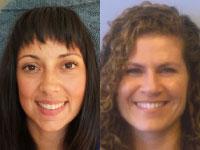 Connie Moreno (left) and Savannah Duguay Rural health minor student Connie Moreno has experienced that in her clinical rotation. In Sonoma County, so recently devastated by wildfires, the need for mental health services is especially acute, she says, but options are thin on the ground. “You really have to know what’s available given the limited access and resources in the community.”
Connie Moreno (left) and Savannah Duguay Rural health minor student Connie Moreno has experienced that in her clinical rotation. In Sonoma County, so recently devastated by wildfires, the need for mental health services is especially acute, she says, but options are thin on the ground. “You really have to know what’s available given the limited access and resources in the community.”
Before the development of this program, students returning to rural settings would get dropped in “at the deep end,” notes Gatewood, both in terms of having to find what resources there are and connect patients with them, and in terms of using all their skills. Now, students have structured clinical support to learn those skills. Rural health minor student Savannah Duguay says that she’s doing more hands-on skills training at her Siskiyou County clinical placement than in any of her previous urban-based rotations. “I was doing things like suturing a cut or burning off skin tags and actinic keratoses right off the bat,” she says.
The Challenges and Rewards of Small-Town Life
Gutierrez, Duguay and Moreno all mention one of the most surprising differences between practicing in an urban and rural environment: the difficulty of setting boundaries with patients.
Because many rural areas have small populations, people tend to know one another, at least casually, outside of the clinician-patient relationship. Duguay says, “I might see a patient at the grocery store, or have a patient I went to high school with. Sometimes it’s complicated.”
Moreno adds, “You have a dual relationship that might be frowned on in another situation but is unavoidable in a small community. So I have to figure out how to navigate this in a way that respects both the patient’s privacy and mine as an autonomous person.”
The small population of some rural areas can also complicate some sexual and reproductive health care. “How do you provide comprehensive reproductive health care when the only pharmacist in town won’t dispense emergency contraception? Or maintain confidentiality when someone’s cousin works at the pharmacy?” Monasterio asks.
Learning from Rural Practitioners
Preceptors, who are all experienced rural health providers, discuss these kinds of challenges in didactic sessions, outlining the strategies they use in their own communities.
Other didactic sessions have included providing trauma-informed care in a rural setting – where some of the trauma that patients have experienced may be different from what clinicians typically encounter in an urban setting – and working with people who are using substances in areas where there are few resources available to help them.
RHAPT’s coordinators hope that learning directly from rural health practitioners and hearing their stories will better prepare students for the realities of rural practice and ultimately reduce provider burnout – an ongoing problem in rural clinics, which often have trouble attracting and retaining experienced clinicians. “It’s important for [students] to hear from providers who are living this experience and not just teaching it from a book,” says Castillo. “They provide real-life expertise.”
Developing Synergy to Build Workforce
 Elizabeth Gatewood RHAPT is also focused on helping rural health care systems develop a workforce through the Teach for UCSF program, which provides training and faculty development to providers in the RCHC. Clinicians receive training on topics like time-efficient teaching, providing feedback, setting goals and expectations and dealing with difficult learners. Teaching experts from UCSF go into communities to provide training.
Elizabeth Gatewood RHAPT is also focused on helping rural health care systems develop a workforce through the Teach for UCSF program, which provides training and faculty development to providers in the RCHC. Clinicians receive training on topics like time-efficient teaching, providing feedback, setting goals and expectations and dealing with difficult learners. Teaching experts from UCSF go into communities to provide training.
“Our goal is sustainability,” says Gatewood. “We hope that if our graduates work [in rural areas], they’ll be able to precept there, and we can cement these relationships to develop these work paths.”
With committed clinicians and preceptors working in community clinics and building relationships, more students from rural areas may become interested in pursuing health care careers. Like many of the current students in the rural health minor, they may then decide to return home to practice, or consider practicing in another rural community.
As Castillo – the product of a rural upbringing – puts it, “It gives these students a greater opportunity to give back to their communities. It’s a beautiful cycle.”

